Information Exchange between GIS and Geospatial ITS Databases Based on a Generic Model
Abstract
:1. Introduction
1.1. Geospatial Information in Intelligent Transport Systems (ITS)
1.2. Information Modelling
1.3. Research Question
2. Materials and Methods
2.1. Research Design
2.2. State of the Art
2.2.1. Literature Search
2.2.2. Overview of Standards and Specifications
2.2.3. Geographic Data Files (GDF)
2.2.4. Navigation Data Standard (NDS) Open Lane Model
2.2.5. OpenDRIVE
2.2.6. Transport Network Intelligent Transport Systems (TN-ITS)
2.2.7. Open Transport Network Format (OpenTNF)
2.2.8. INSPIRE Transport Networks (INSPIRE TN)
2.2.9. CityGML and LandInfra/InfraGML
2.2.10. DATEX II and TPEG2
2.2.11. Other Research and Solutions
2.3. Evaluation of Solutions
3. Results
3.1. A Generic Model for the Exchange of Road-Related Geospatial Information
3.2. Feature Catalogue Exchange Model
3.3. Feature Exchange Model
4. Case Study
4.1. Purpose and Workflow
4.2. INSPIRE TN
4.3. GDF
5. Discussion
6. Conclusions
Author Contributions
Funding
Acknowledgments
Conflicts of Interest
References
- Zang, A.; Chen, X.; Trajcevski, G. High definition maps in urban context. Sigspatial Spec. 2018, 10, 15–20. [Google Scholar] [CrossRef]
- Zang, A.; Li, Z.; Doria, D.; Trajcevski, G. Accurate vehicle self-localization in high definition map dataset. In Proceedings of the 1st ACM SIGSPATIAL Workshop on High-Precision Maps and Intelligent Applications for Autonomous Vehicles, Redondo Beach, CA, USA, 7–10 November 2017; p. 2. [Google Scholar]
- Jomrich, F.; Sharma, A.; Rückelt, T.; Burgstahler, D.; Böhnstedt, D. Dynamic Map Update Protocol for Highly Automated Driving Vehicles. In Proceedings of the 3rd International Conference on Vehicle Technology and Intelligent Transport Systems (VEHITS 2017), Porto, Portugal, 22–24 April 2017. [Google Scholar]
- Kleine-Besten, T.; Behrens, R.; Pöchmüller, W.; Engelsberg, A. Digital Maps for ADAS. In Handbook of Driver Assistance Systems: Basic Information, Components and Systems for Active Safety and Comfort; Springer: Berlin/Heidelberg, Germany, 2016; pp. 647–661. [Google Scholar]
- Borzacchiello, M.T.; Boguslawski, R.; Pignatelli, F. Improving Accuracy in Road Safety Data Exchange for Navigation Systems: European Union Location Framework Transportation Pilot; European Union: Brussels, Belgium, 2016. [Google Scholar]
- Richter, A.; Friedl, H.; Scholz, M. Beyond OSM–Alternative Data Sources and Approaches Enhancing Generation of Road Networks for Traffic and Driving Simulations. In Proceedings of the SUMO2016–Traffic, Mobility, and Logistics, Berlin, Germany, 23–25 May 2016; pp. 23–25. [Google Scholar]
- Richter, A.; Scholz, M. Deploying guidelines and a simplified data model to provide real world geodata in driving simulators and driving automation. Transp. Res. Part F Traff. Psychol. Behav. 2017. [Google Scholar] [CrossRef]
- Grubmüller, S.; Plihal, J.; Nedoma, P. Automated Driving from the View of Technical Standards. In Automated Driving; Springer: Berlin/Heidelberg, Germany, 2017; pp. 29–40. [Google Scholar]
- Morales, L.G.; Orrell, T. Data Interoperability: A Practitioner’s Guide to Joining up Data in the Development Sector. Available online: http://www.data4sdgs.org/sites/default/files/services_files/Interoperability%20-%20A%20practitioner%E2%80%99s%20guide%20to%20joining-up%20data%20in%20the%20development%20sector.pdf (accessed on 14 March 2019).
- Object Management Group. Unified Modelling Language Specification Version 2.5.1; Object Management Group: Needham, MA, USA, 2017. [Google Scholar]
- Miles, R.R.; Hamilton, K. Learning UML 2.0, 1st ed.; O’Reilly: Sebastopol, CA, USA, 2006. [Google Scholar]
- Object Management Group. Model Driven Architecture (MDA) Guide, rev. 2.0.; Object Management Group: Needham, MA, USA, 2014. [Google Scholar]
- Coetzee, S.; Plews, R.; Brodeur, J.; Hjelmager, J.; Jones, A.; Jetlund, K.; Grillmayer, R.; Wasström, C. Standards—Making Geographic Information Discoverable, Accessible and Usable for Modern Cartography. In Service-Oriented Mapping: Changing Paradigm in Map Production and Geoinformation Management; Döllner, J., Jobst, M., Schmitz, P., Eds.; Springer International Publishing: Cham, Switzerland, 2019; pp. 325–344. [Google Scholar] [CrossRef]
- ISO/TC 211. ISO 19103:2015 Geographic Information—Conceptual Schema Language; ISO: Geneva, Switzerland, 2015. [Google Scholar]
- ISO/TC 211. ISO 19109:2015 Geographic Information—Rules for Application Schema; ISO: Geneva, Switzerland, 2015. [Google Scholar]
- ISO/TC 211. ISO 19136:2007 Geographic Information—Geography Markup Language (GML); ISO: Geneva, Switzerland, 2007. [Google Scholar]
- INSPIRE. INSPIRE Data Specification on Transport Networks–Guidelines; INSPIRE Thematic Working Group Transport Networks: Brussels, Belgium, 2014. [Google Scholar]
- OGC. OGC City Geography Markup Language (CityGML) Encoding Standard Version 2.0; Open Geospatial Consortium: Wayland, MA, USA, 2012. [Google Scholar]
- OGC. OGC InfraGML 1.0—Part 0–LandInfra Core—Encoding Standard; Open Geospatial Consortium: Wayland, MA, USA, 2017. [Google Scholar]
- OGC. OGC InfraGML 1.0—Part 3–Alignments—Encoding Standard; Open Geospatial Consortium: Wayland, MA, USA, 2017. [Google Scholar]
- OGC. OGC InfraGML 1.0—Part 4–LandInfra Roads—Encoding Standard; Open Geospatial Consortium: Wayland, MA, USA, 2017. [Google Scholar]
- Navigation Data Standard. Open Lane Model Documentation; Navigation Data Standard (NDS) e.V.: Wolfsburg, Germany, 2016. [Google Scholar]
- ISO/TC 204. ISO 14825:2011 Intelligent Transport Systems—Geographic Data Files (GDF)—GDF5.0; ISO: Geneva, Switzerland, 2011. [Google Scholar]
- ERTICO—ITS Europe. TN-ITS GO. Available online: https://tn-its.eu/tn-its-go (accessed on 15 January 2019).
- CEN/TC 278. CEN/TS 17268:2018 Intelligent Transport Systems—Its Spatial Data—Data Exchange on Changes in Road Attributes; CEN: Brussels, Belgium, 2018. [Google Scholar]
- Interactive Instruments GmbH. ShapeChange. Available online: http://shapechange.net (accessed on 15 January 2019).
- ISO/TC 204. ISO/DIS 20524-1 Intelligent Transport Systems—Geographic Data Files (GDF) GDF5.1—Part 1: Application Independent Map Data Shared between Multiple Sources; ISO: Geneva, Switzerland, 2017. [Google Scholar]
- ISO/TC 204. ISO/CD 20524-2 Intelligent Transport Systems—Geographic Data Files (GDF)—GDF5.1—Part 2: Map Data Used in Automated Driving Systems, Cooperative ITS, and Multi-Modal Transport; ISO: Geneva, Switzerland, 2017. [Google Scholar]
- OpenDRIVE. OpenDRIVE Format Specification; rev. 1.4; VIRES Simulationstechnologie GmbH: Bad Aibling, Germany, 2015. [Google Scholar]
- OpenTNF.org. OpenTNF White Paper Version 1.0. Available online: http://www.opentnf.org (accessed on 15 January 2019).
- CEN/TC 278. EN 16157-1:2018 Intelligent Transport Systems—DATEX II Data Exchange Specifications for Traffic Management and Information—Part 1: Context and Framework; CEN: Brussels, Belgium, 2018. [Google Scholar]
- CEN/TC 278. FprEN 16157-2 Intelligent Transport Systems—DATEX II Data Exchange Specifications for Traffic Management and Information—Part 2: Location Referencing; CEN: Brussels, Belgium, 2018. [Google Scholar]
- CEN/TC 278. EN 16157-3:2018 Intelligent Transport Systems—DATEX II Data Exchange Specifications for Traffic Management and Information—Part 3: Situation Publication; CEN: Brussels, Belgium, 2018. [Google Scholar]
- CEN/TC 278. EN 16157-7:2018 Intelligent Transport Systems—DATEX II Data Exchange Specifications for Traffic Management and Information—Part 7: Common Data Elements; CEN: Brussels, Belgium, 2018. [Google Scholar]
- ISO/TC 204. ISO/TS 21219-2:2014 Intelligent Transport Systems—Traffic and Travel Information (TTI) via Transport Protocol Experts Group, Generation 2 (TPEG2)—Part 2: UML Modelling Rules; ISO: Geneva, Switzerland, 2014. [Google Scholar]
- ISO/TC 204. ISO/TS 21219-3:2015 Intelligent Transport Systems—Traffic and Travel Information (TTI) via Transport Protocol Experts Group, Generation 2 (TPEG2)—Part 3: UML to Binary Conversion Rules; ISO: Geneva, Switzerland, 2015. [Google Scholar]
- ISO/TC 204. ISO/TS 21219-4:2015 Intelligent Transport Systems—Traffic and Travel Information (TTI) via Transport Protocol Experts Group, Generation 2 (TPEG2)—Part 4: UML to XML Conversion Rules; ISO: Geneva, Switzerland, 2015. [Google Scholar]
- ISO/TC 204. ISO/TS 21219-7:2017 Intelligent Transport Systems—Traffic and Travel Information (TTI) via Transport Protocol Experts Group, Generation 2 (TPEG2)—Part 7: Location Referencing Container (TPEG2-LRC); ISO: Geneva, Switzerland, 2017. [Google Scholar]
- Van Essena, R.; Hiestermannb, V. “X-GDF”―The ISO model for geographic information for ITS. In Proceedings of the ISPRS Workshop on Service and Application of Spatial Data Infrastructure, Hangzhou, China, 14–16 October 2004. [Google Scholar]
- Shibata, J. ISO TC204 WG3: ITS Database Technology PROGRESS REPORT as of March 12, 2018; ISO: Geneva, Switzerland, 2018. [Google Scholar]
- Althoff, M.; Urban, S.; Koschi, M. Automatic Conversion of Road Networks from OpenDRIVE to Lanelets. In Proceedings of the 2018 IEEE International Conference on Service Operations and Logistics, and Informatics (SOLI), Singapore, 31 July–2 August 2018; pp. 157–162. [Google Scholar]
- Wikström, L.; Landwehr, M.; Bock, H.; Nasr, A.; Wevers, K.; Svensk, P.-O.; T’Siobbel, S.; Boterbergh, B.; Blaive, L.; Hamish, K.; et al. ROSATTE: ROad Safety ATTributes Exchange Infrastructure in Europe: Deliverable D3.1: Specification of Data Exchange Methods; ERTICO - ITS Europe: Brussels, Belgium, 2009. [Google Scholar]
- Niestroj, M.G.; McMeekin, D.A.; Helmholz, P. Overview of standards towards road asset information exchange. Int. Arch. Photogramm. Remote Sens. Spat. Inf. Sci. 2018, XLII-4, 443–450. [Google Scholar] [CrossRef]
- European Parliament and the Council of the European Union. Directive 2007/2/EC of the European Parliament and of the Council of the European Union of 14 March 2007 establishing an Infrastructure for Spatial Information in the European Community (INSPIRE). EUR-LEX Off. J. Eur. Union 2007, 30, 270–283. [Google Scholar]
- INSPIRE. INSPIRE Data Specifications—Base Models—Generic Network Model; INSPIRE Drafting Team “Data Specifications”: Brussels, Belgium, 2013. [Google Scholar]
- European Parliament and the Council of the European Union. Directive 2010/40/EU of the European Parliament and of the Council of 7 July 2010 on the framework for the deployment of Intelligent Transport Systems in the field of road transport and for interfaces with other modes of transport. EUR-LEX Off. J. Eur. Union 2010, 207, 1–13. [Google Scholar]
- European Parliament and the Council of the European Union. Commission Delegated Regulation (EU) 2015/962 of 18 December 2014 supplementing Directive 2010/40/EU of the European Parliament and of the Council with regard to the provision of EU-wide real-time traffic information services. EUR-LEX Off. J. Eur. Union 2014, 157, 21–31. [Google Scholar]
- Vandezande, N.; Janssen, K. The ITS Directive: More than a timeframe with privacy concerns and a means for access to public data for digital road maps? Comput. Law Secur. Rev. 2012, 28, 416–428. [Google Scholar] [CrossRef]
- Beil, C.; Kolbe, T.H. CityGML and the streets of New York-A proposal for detailed street space modelling. ISPRS Ann. Photogramm. Remote Sens. Spat. Inf. Sci. 2017, IV-4/W5, 9–16. [Google Scholar] [CrossRef]
- TISA Executive Office; EasyWay. General Description of the Easyway/Tisa Demonstration Functionality. Available online: http://www.easyway-its.eu (accessed on 15 January 2019).
- Kwoczek, S.; Di Martino, S.; Rustemeyer, T.; Nejdl, W. An architecture to process massive vehicular traffic data. In Proceedings of the 10th International Conference on P2P, Parallel, Grid, Cloud and Internet Computing, Krakow, Poland, 4–6 November 2015; pp. 515–520. [Google Scholar]
- Zhi-Ren, S.; Min, H.; Hai-Bin, W. A conceptual multi-level data model for road networks. In Proceedings of the Fifth International Conference on Intelligent Computation Technology and Automation (ICICTA), Zhangjiajie, China, 12–14 January 2014; pp. 712–715. [Google Scholar]
- Liu, C.; Jiang, K.; Xiao, Z.; Cao, Z.; Yang, D. Lane-level route planning based on a multi-layer map model. In Proceedings of the IEEE 20th International Conference on Intelligent Transportation Systems (ITSC), Yokohama, Japan, 16–19 October 2017; pp. 1–7. [Google Scholar]
- Chen, S.; Tan, J.; Claramunt, C.; Ray, C. Multi-scale and multi-modal GIS-T data model. J. Transp. Geogr. 2011, 19, 147–161. [Google Scholar] [CrossRef]
- Sharma, A. Differential Map Updates for Highly Automated Driving and Enhanced Driver Assistance Services. Master’s Thesis, Technische Universität Darmstadt, Darmstadt, Germany, 2016. [Google Scholar]
- Runde, M. Strategies for Automated Updating of Road Networks for Driving Simulations. Master’s Thesis, Westfälische Wilhelms-Universität Münster, Münster, Germany, 2017. [Google Scholar]
- Barsi, A.; Poto, V.; Somogyi, A.; Lovas, T.; Tihanyi, V.; Szalay, Z. Supporting autonomous vehicles by creating HD maps. Prod. Eng. Arch. 2017, 16. [Google Scholar] [CrossRef]
- Czarnecki, K. Operational World Model Ontology for Automated Driving Systems—Part 1: Road Structure; Waterloo Intelligent Systems Engineering Lab (WISE) Report; Waterloo Intelligent Systems Engineering Lab: Waterloo, ON, Canada, 2018. [Google Scholar]
- ISO/TC 211. ISO 19101-1:2014 Geographic Information—Reference Model—Part 1: Fundamentals; ISO: Geneva, Switzerland, 2014. [Google Scholar]
- ISO/TC 211. ISO 19110:2016 Geographic Information—Methodology for Feature Cataloguing; ISO: Geneva, Switzerland, 2016. [Google Scholar]
- Campbell, J.E.; Shin, M. Essentials of Geographic Information Systems; FlatWorld Pubislding: Boston, MA, USA, 2017. [Google Scholar]
- Sparx Systems Pty Ltd. Enterprise Architect Version 14. Available online: https://sparxsystems.com/products/ea/index.html (accessed on 15 January 2019).
- Safe Software Inc. FME 2018.1. Available online: https://www.safe.com/fme/fme-desktop/ (accessed on 15 January 2019).
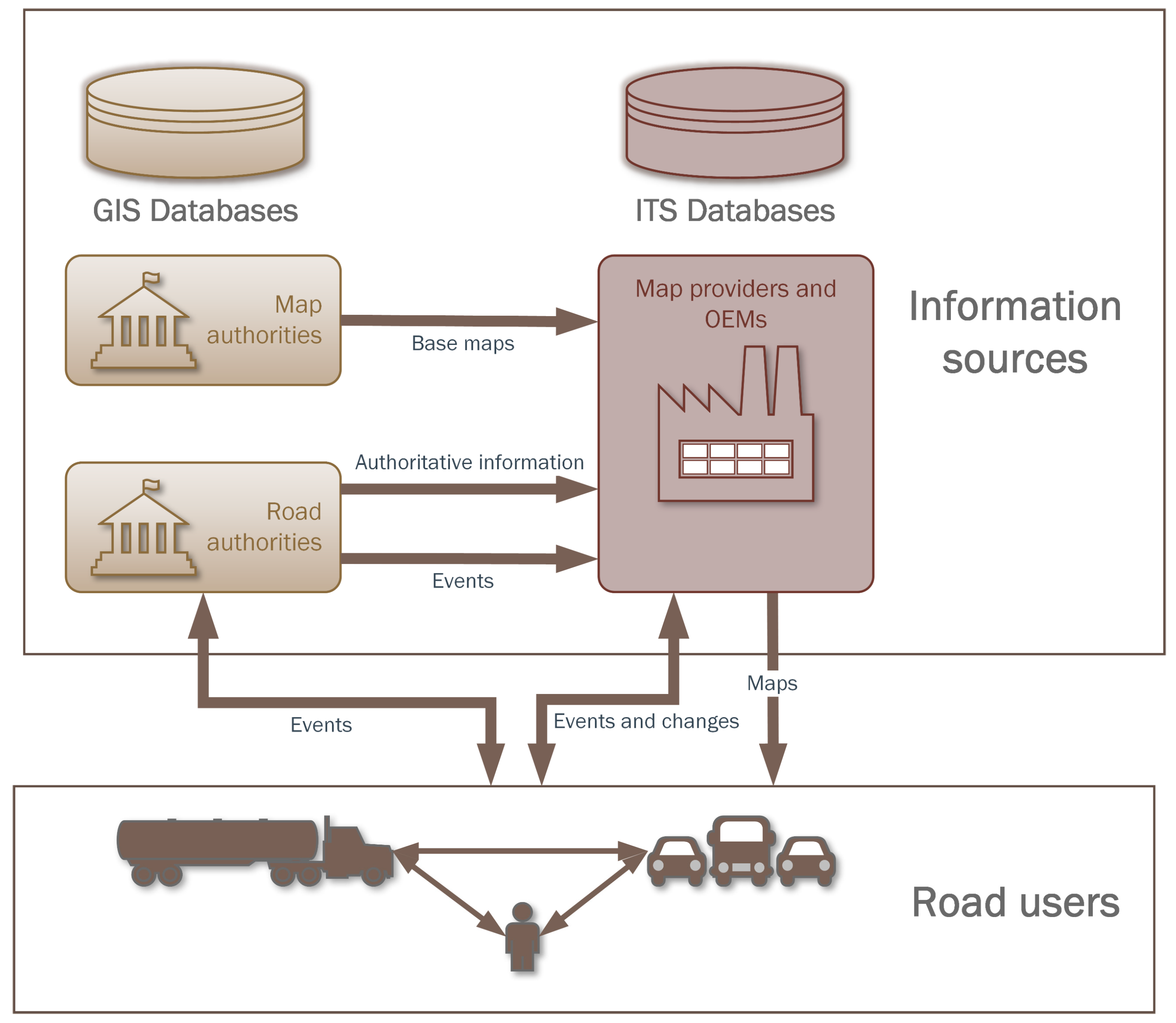
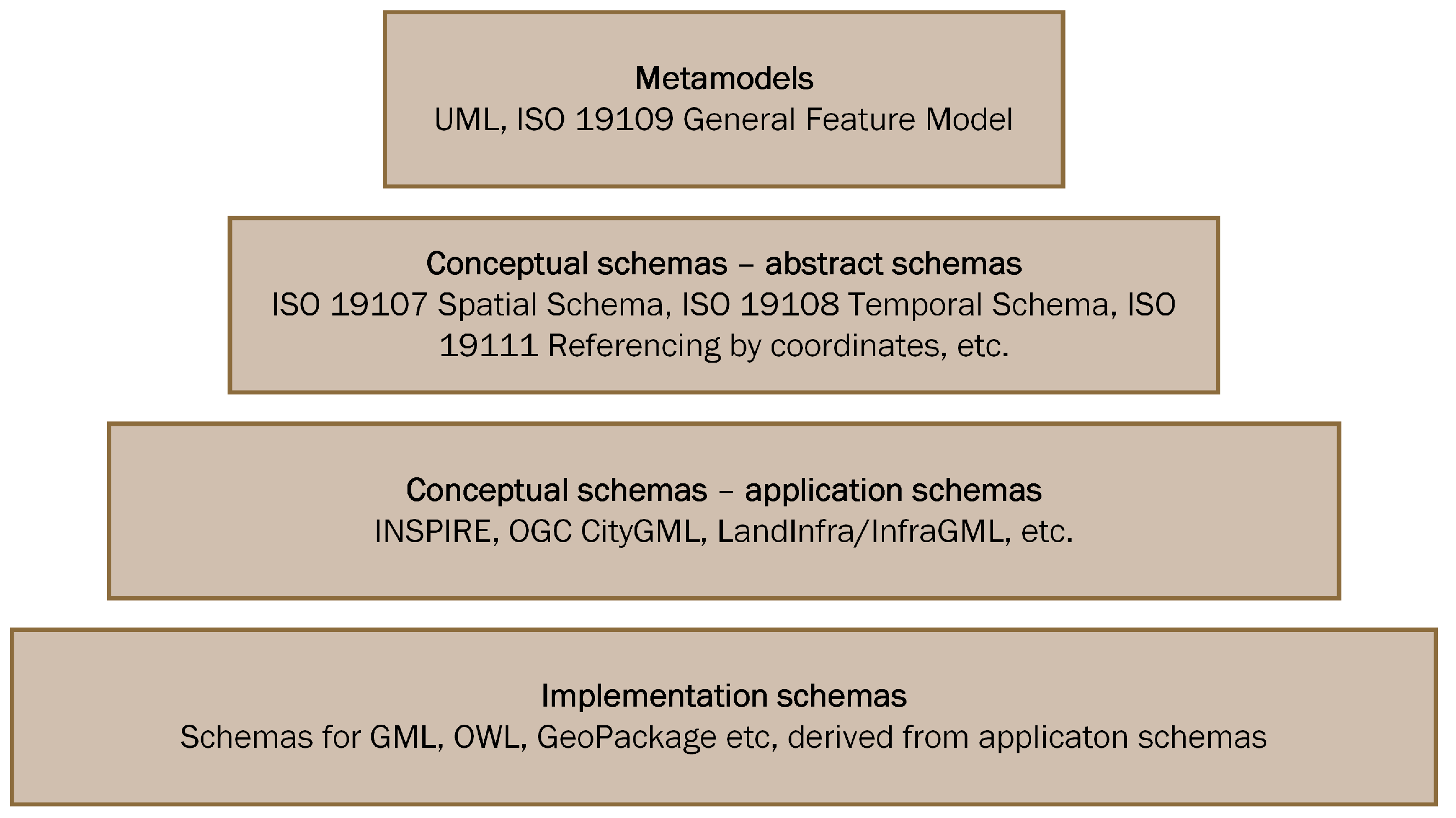
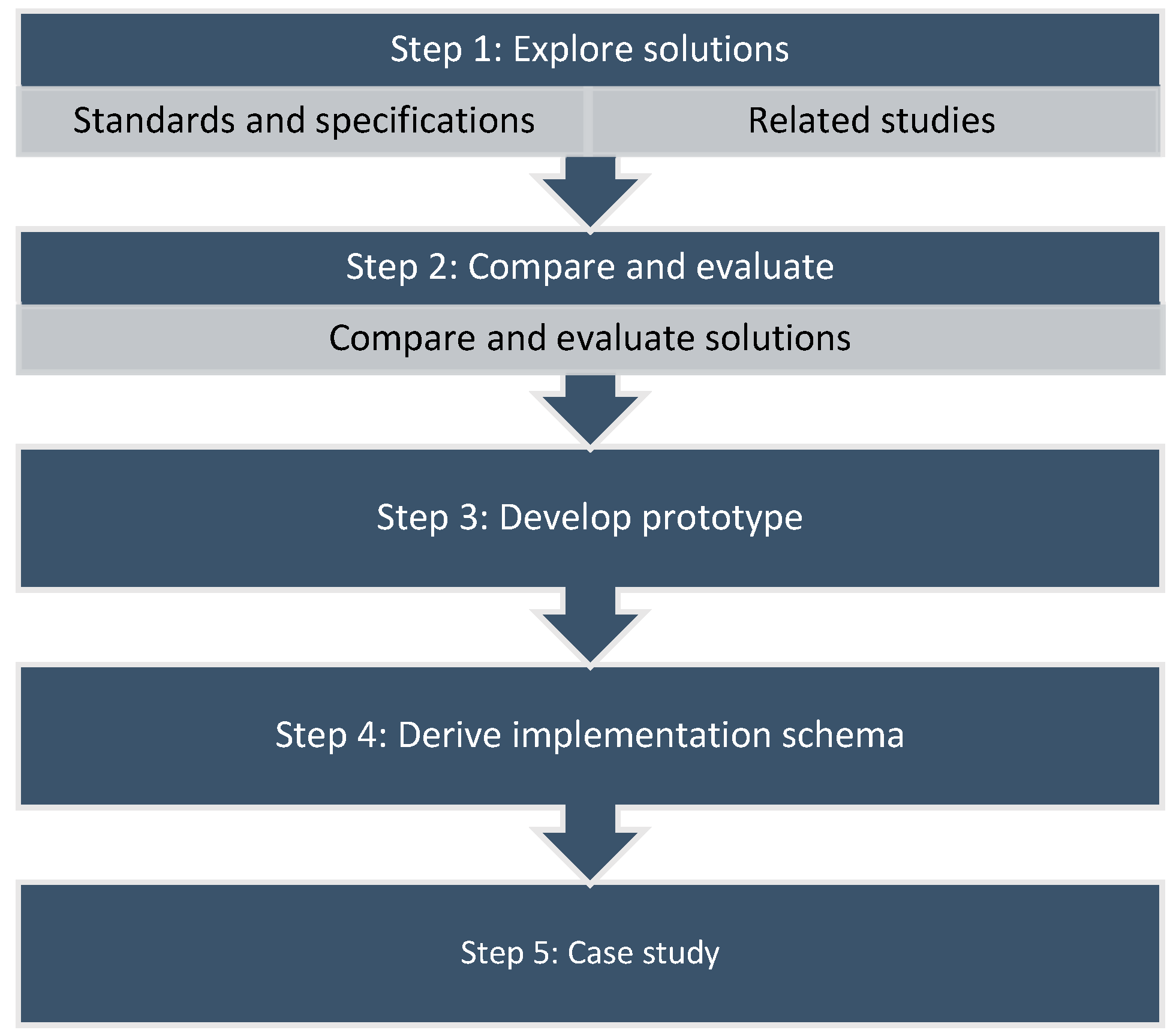
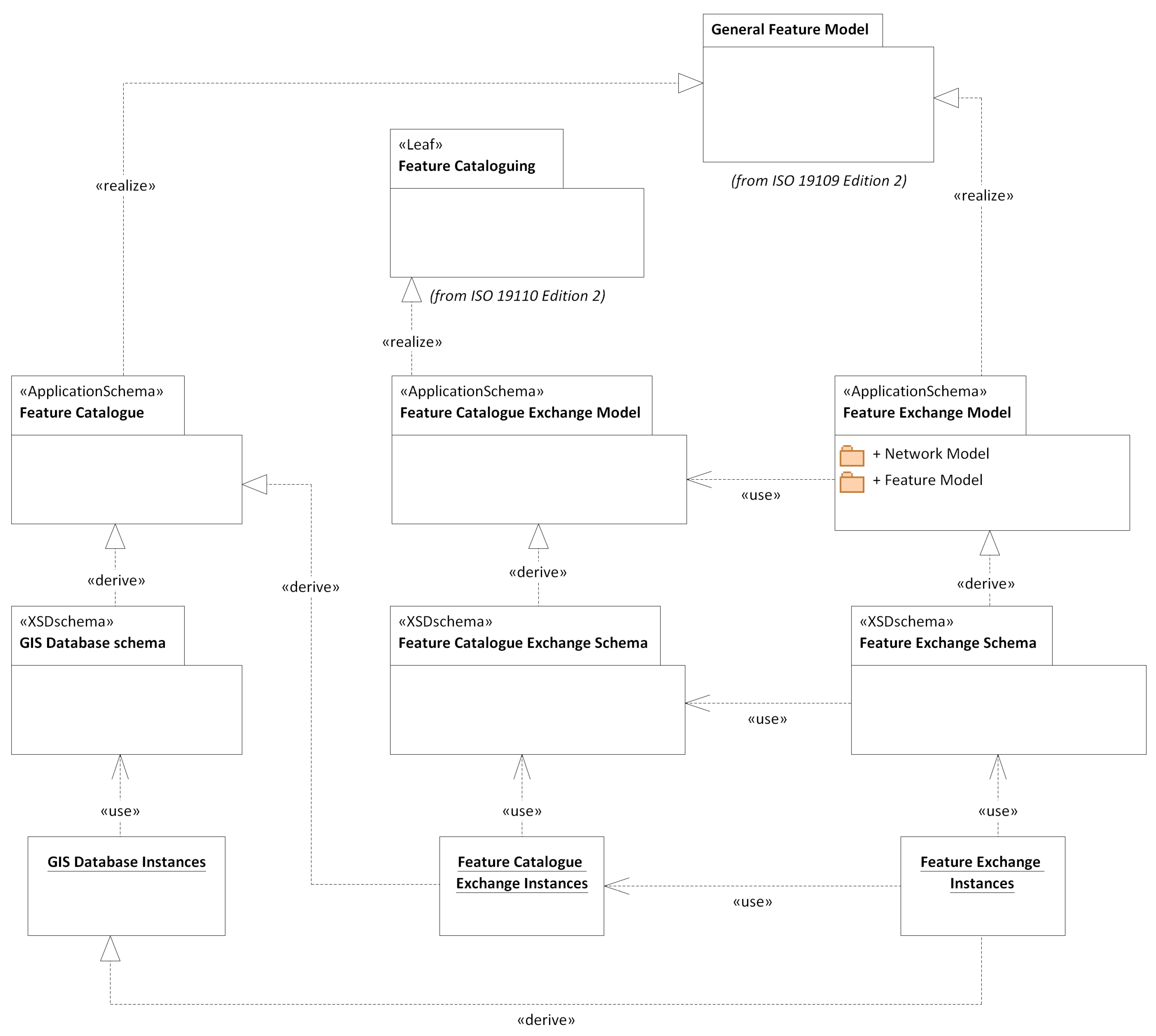
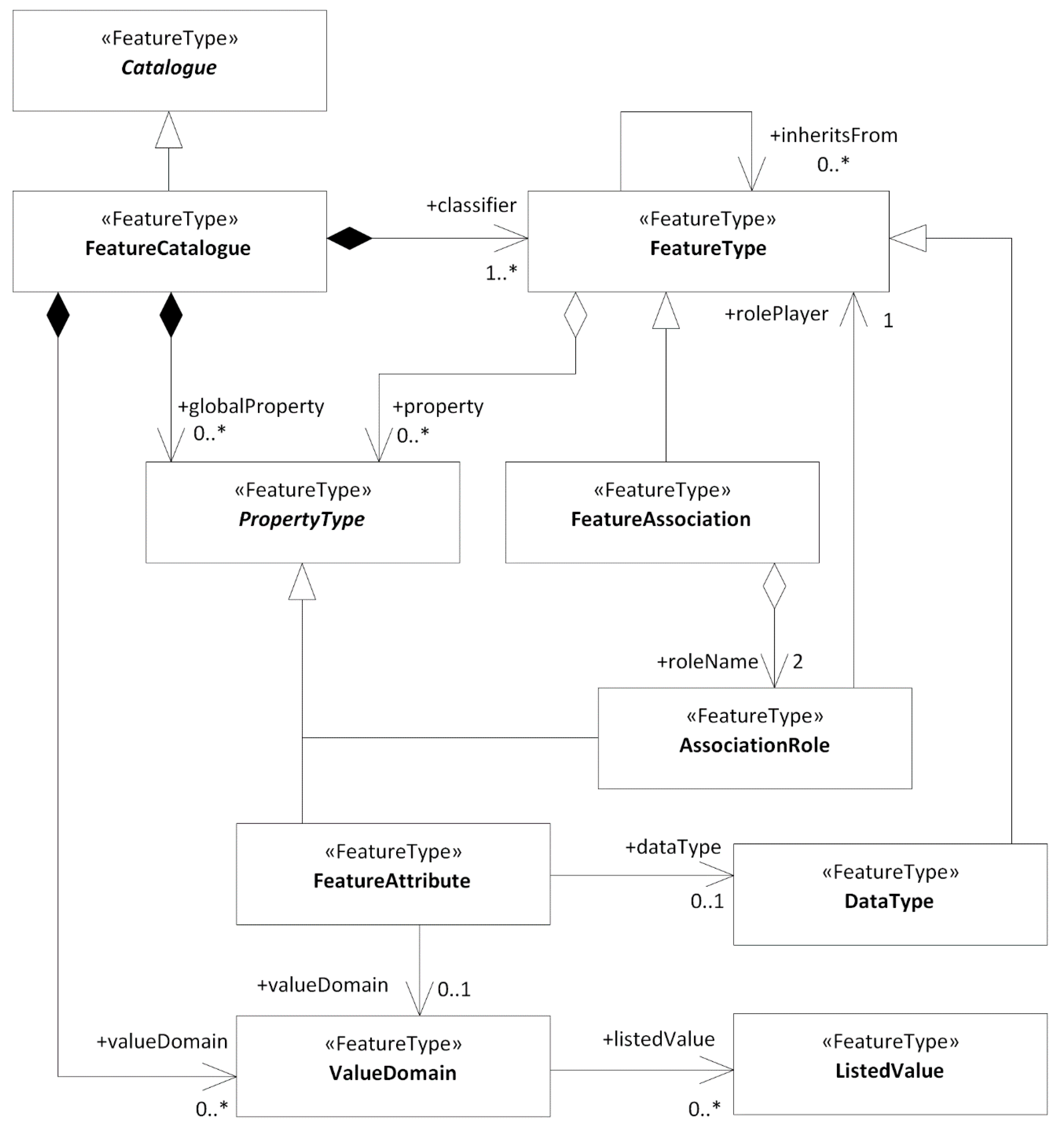
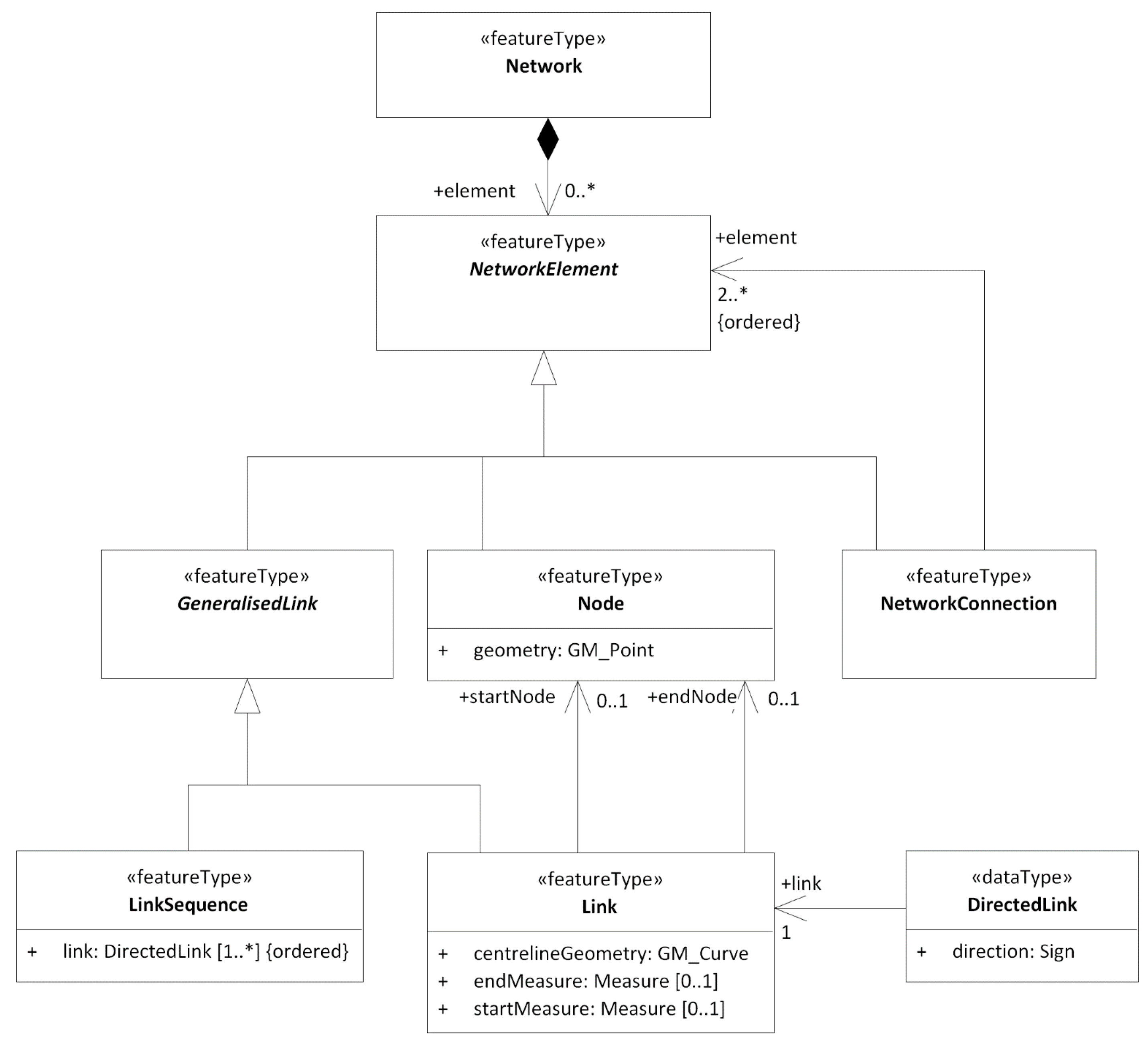
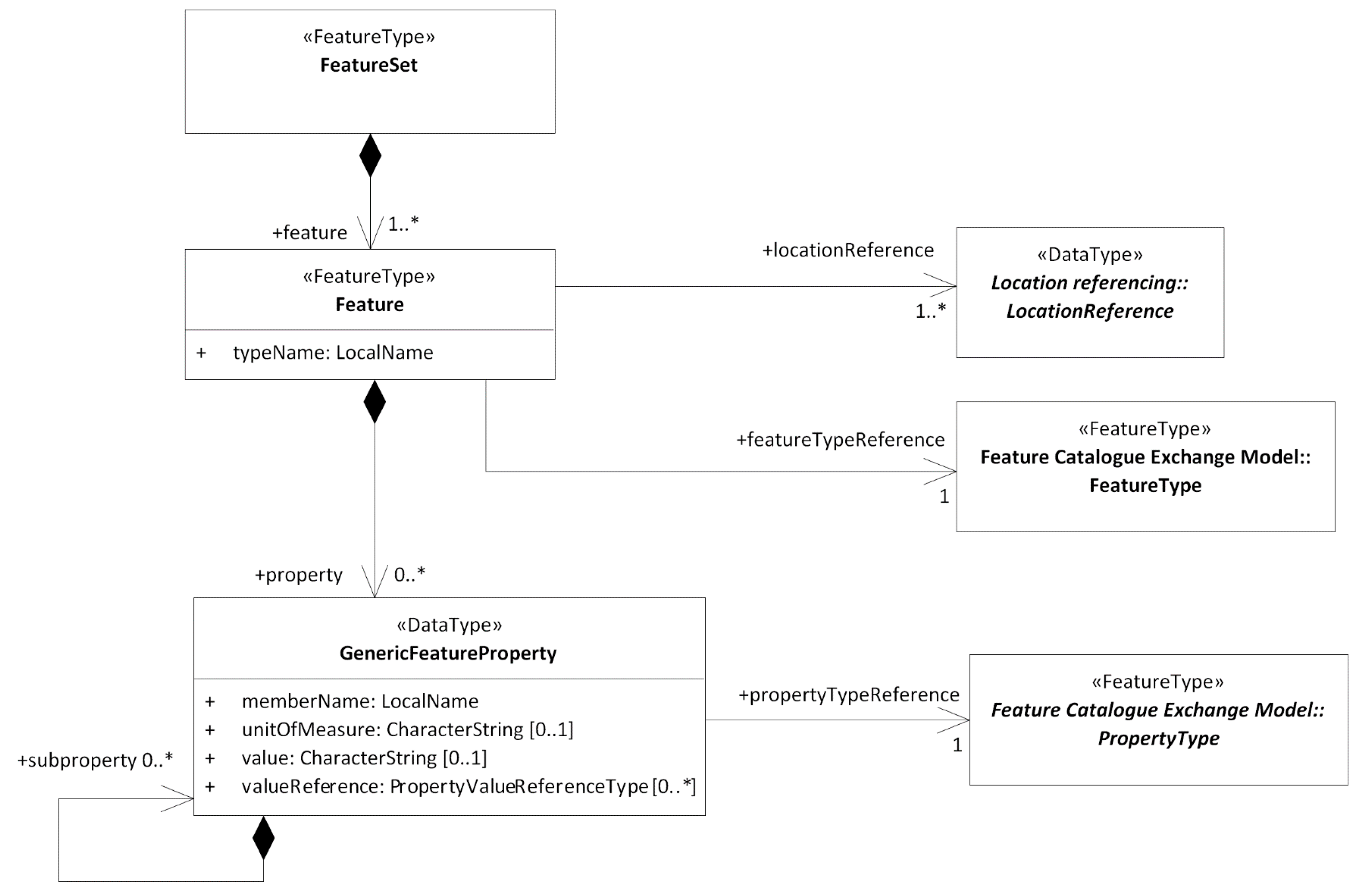
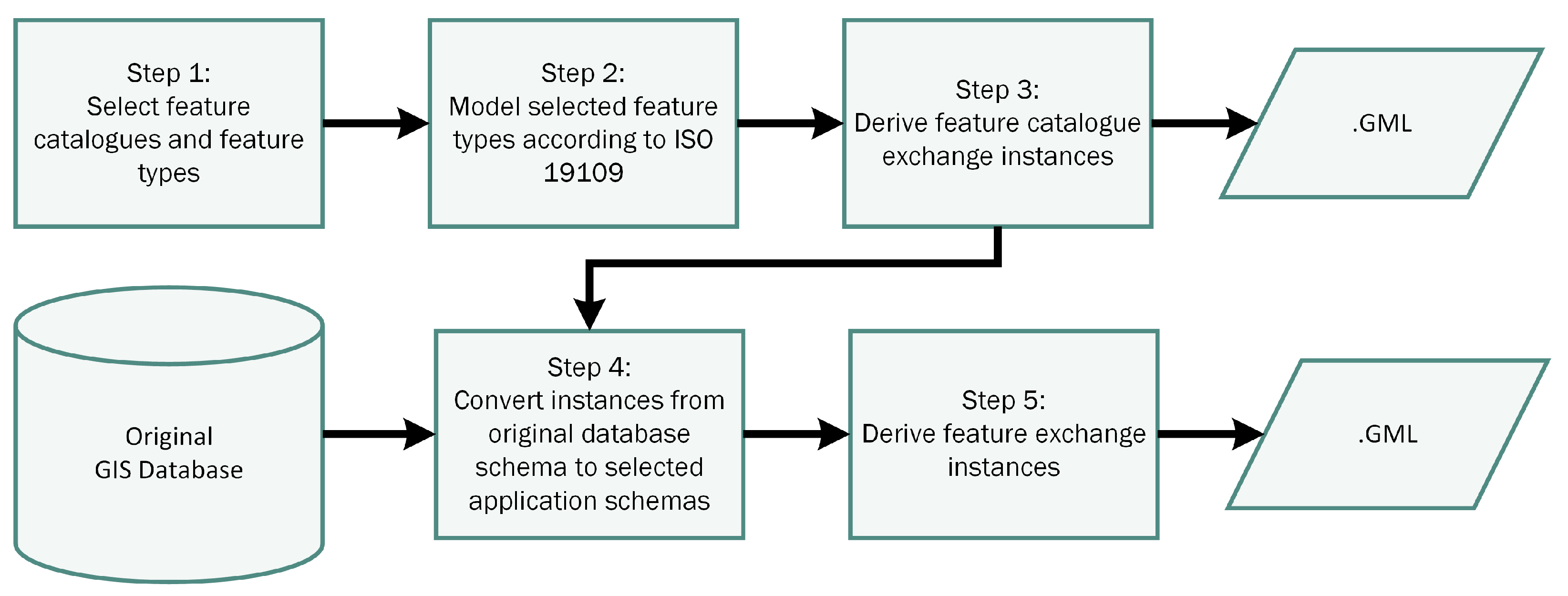

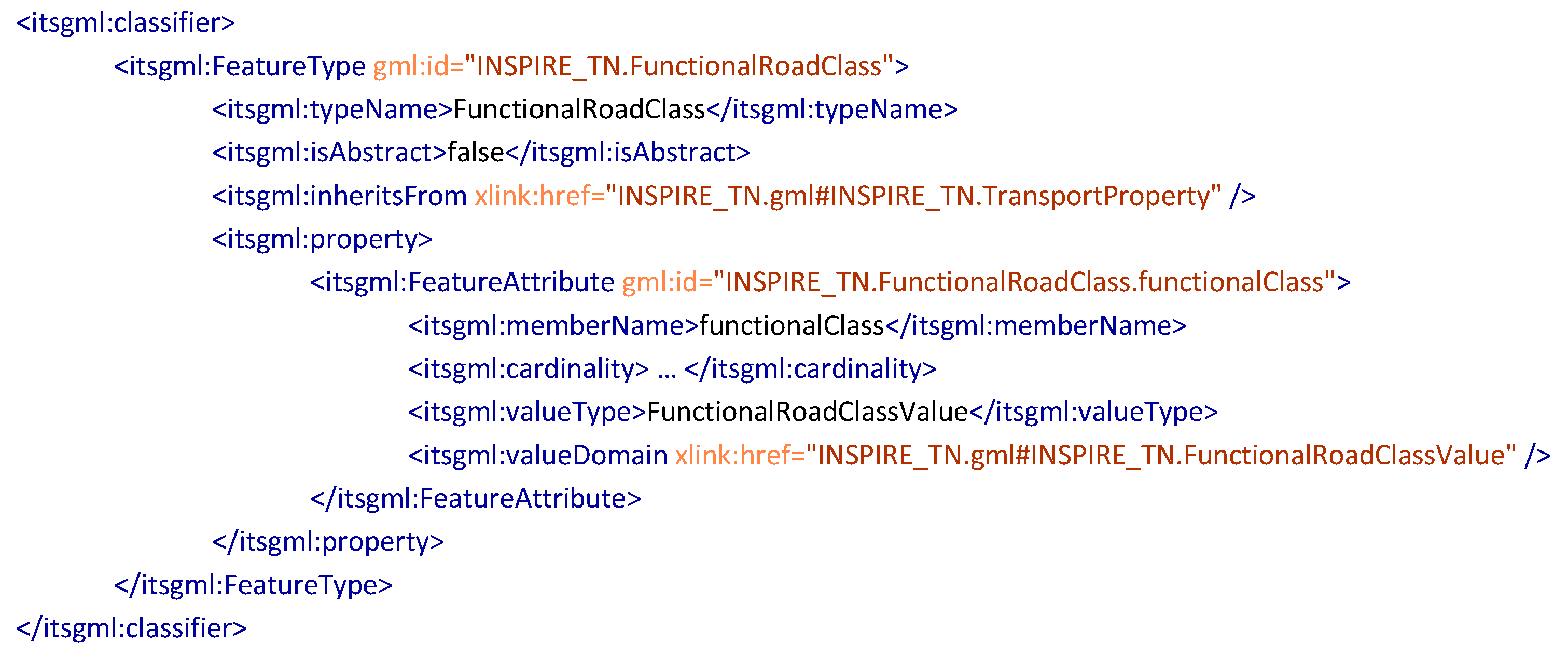
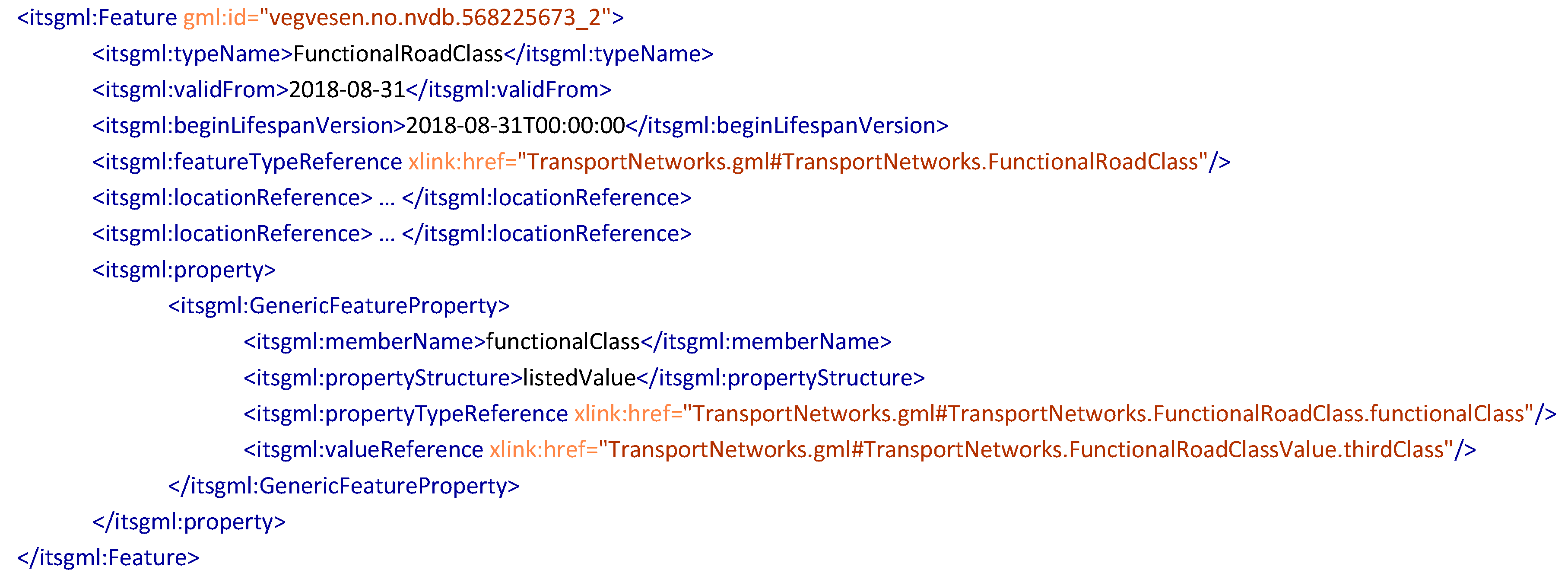
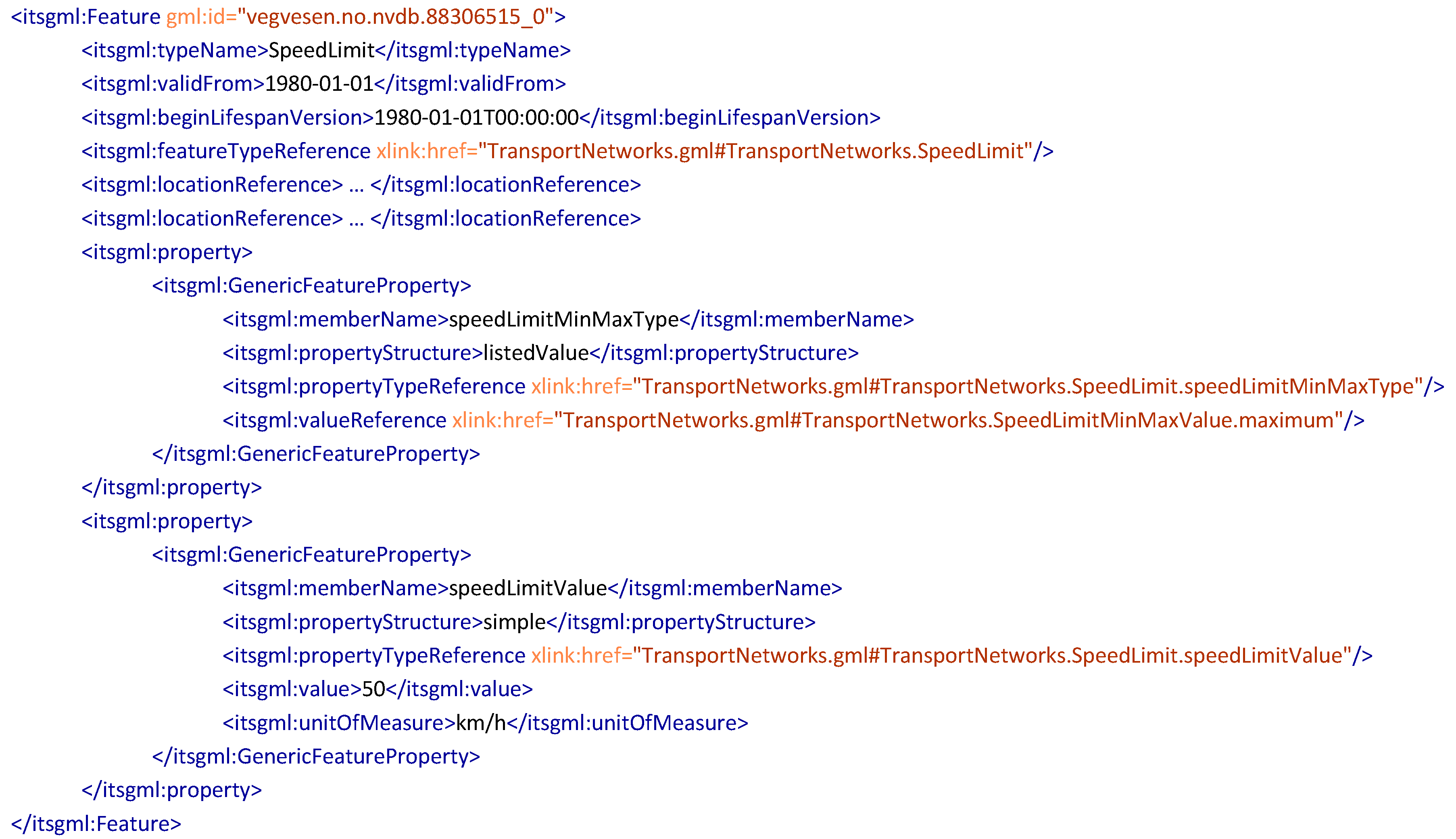
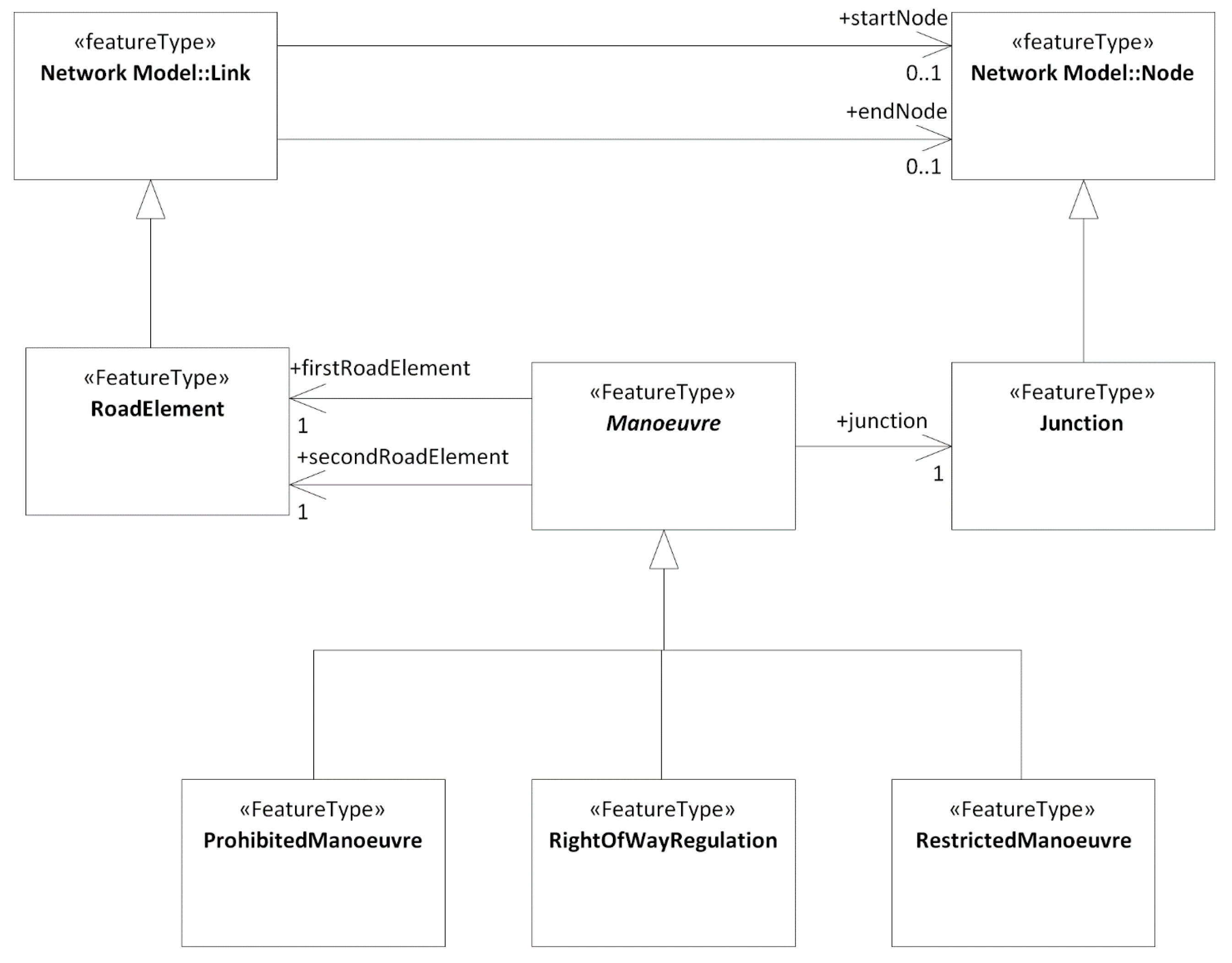

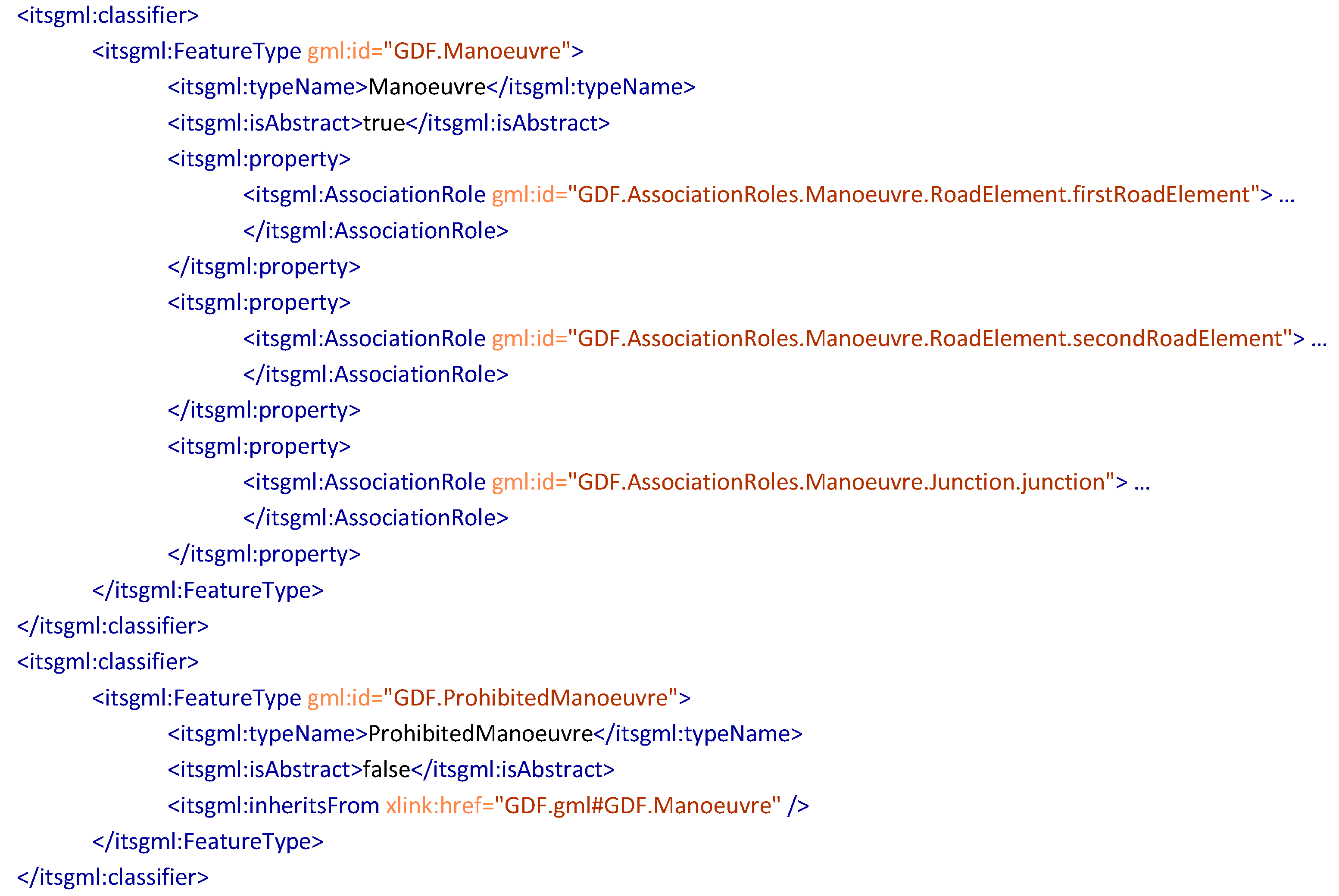
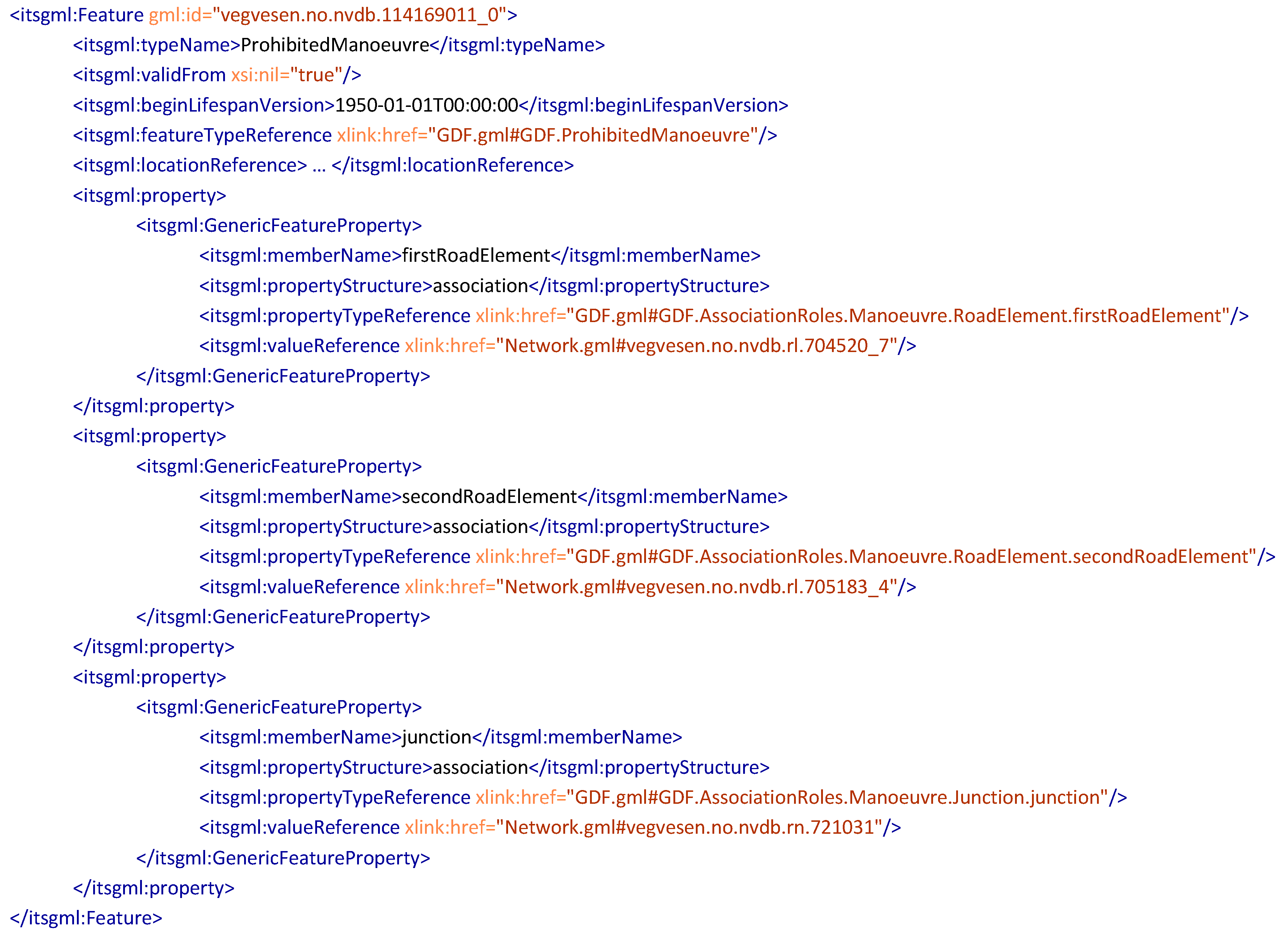
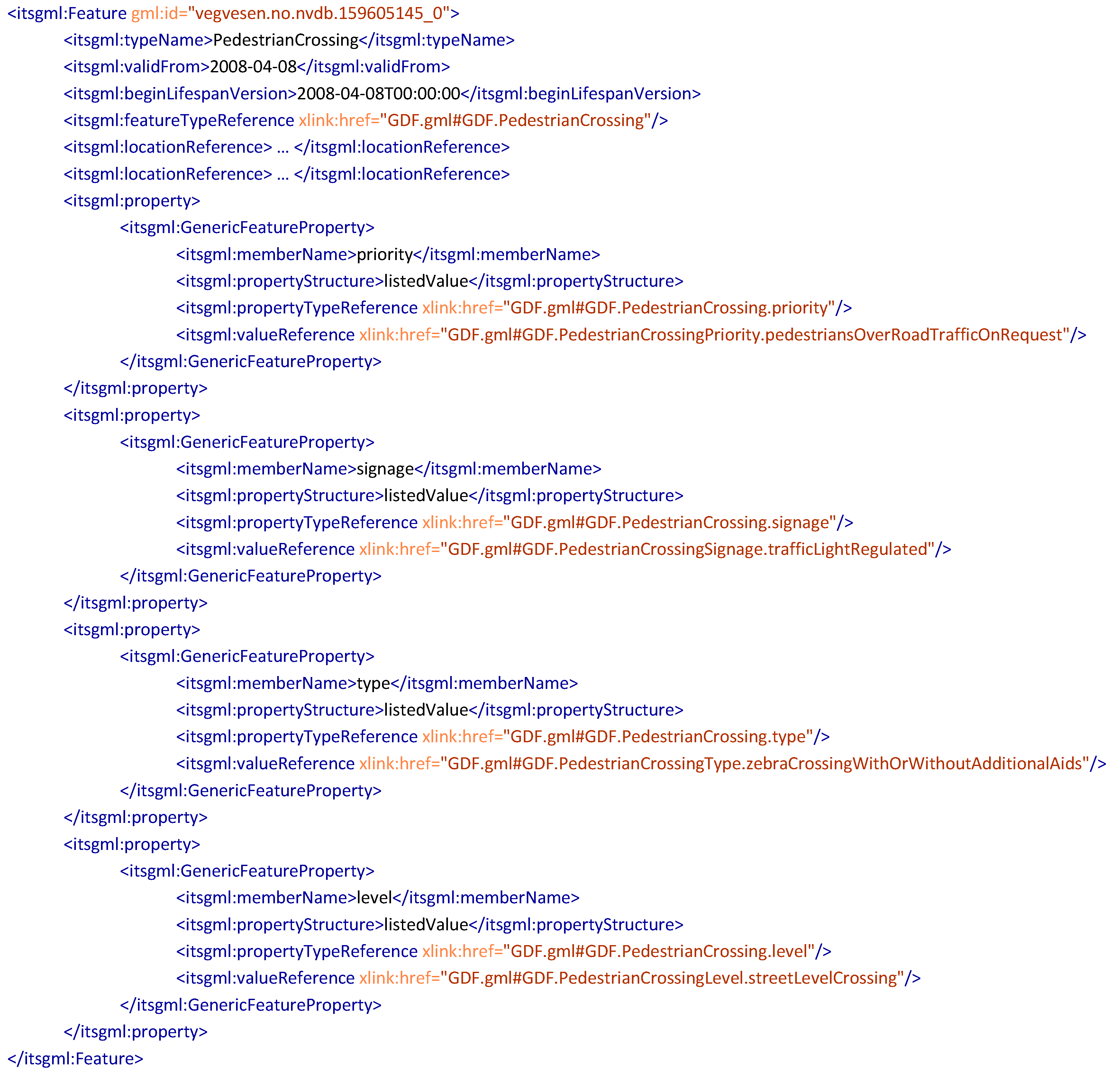
| Standard/Specification | Title |
|---|---|
| GDF | ISO 14825:2011 Geographic Data Files (GDF) – GDF 5.0 [23] ISO/DIS 20524-1 Geographic Data Files (GDF) – GDF5.1 – Part 1: Application independent map data shared between multiple sources [27] ISO/CD 20524-2 Geographic Data Files (GDF) – GDF5.1 – Part 2: Map data used in automated driving systems, cooperative ITS, and multi-modal transport [28] |
| NDS Open Lane Model | Navigation Data Standard (NDS) Open Lane Model version 1.0 [22] |
| OpenDRIVE | OpenDRIVE version 1.5 [29] |
| TN-ITS | FprCEN/TS 17268 data exchange on changes in road attributes [25] Transport Network Intelligent Transport Systems (TN-ITS) |
| OpenTNF | Open Transport Network Format (OpenTNF) 1.0 [30] |
| INSPIRE TN | INSPIRE Data Specification on Transport Networks [17] |
| CityGML | OGC City Geography Markup Language (CityGML) Encoding Standard version 2.0 [18] |
| LandInfra/InfraGML | OGC LandInfra and InfraGML 1.0 Encoding Standard [19,20,21] |
| DATEX II | CEN/TS 16157 DATEX II data exchange specification for traffic management and information [31,32,33,34] |
| TPEG2 | ISO/TS 21219 Traffic and Travel Information (TTI) via Transport Protocol Expert Group, Generation 2 (TPEG2) [35,36,37,38] |
| Requirement | Description |
|---|---|
| ISO/TC 211 Model Driven Architecture (MDA) | The ISO/TC 211 MDA approach is the foundation of information modelling in the GIS domain. Adapting an information model based on a different approach for use in GIS may be a complicated task that requires fundamental changes. Therefore, solutions for exchanging information from GIS databases should be based on the ISO/TC 211 MDA approach. |
| GIS exchange format | Using a familiar exchange format from the GIS domain, such as GML or GeoPackage, is vital to avoid additional conversions and, thereby, to enable efficient exchange from GIS databases. |
| Feature catalogue | Advanced Driver Assistance Systems (ADAS) and systems for automated driving need a range of features for legal and safe navigation, including regulation features such as speed limits and other features such as lane dividers. Unambiguous descriptions of these classifications of the real world in a feature catalogue are essential for a common understanding of the exchanged information. |
| Feature catalogue exchange model | A feature catalogue exchange model is needed for sharing the classifications of the real world described in the feature catalogue with the users of the information. Furthermore, as the real world is changing (e.g., if a new valid value for speed limits is introduced, a new type of sign or a new kind of access regulation is introduced), the feature catalogue must also be modified and shared with receivers of the exchanged information. Using a feature catalogue exchange model for exchanging the feature catalogue together with the features gives the flexibility of maintaining a dynamic feature catalogue outside of the primary standard or specification. Contrary to this, a standardized feature catalogue in an ISO standard cannot be modified without revising the standard. |
| Network model | A navigable digital network is the foundation of route planning and navigation and must have both geometry and topology of the network elements, together with mechanisms for relating features to the network. |
| Generic feature exchange model | Feature exchange can either be based on specific feature models precisely as they are modelled in the feature catalogues, or on a generic feature model that refers to external descriptions of features and their properties in feature catalogues. The combination of a feature catalogue exchange model and a generic feature exchange model gives the advantage of keeping the main feature exchange model stable while the feature catalogue is modified, and the feature exchange model may also be used with different feature catalogues. |
| Solution | ISO/TC 211 MDA | GIS Exchange Format | Feature Catalogue | Feature Catalogue Exchange Model | Network Model | Generic Feature Exchange Model |
|---|---|---|---|---|---|---|
| GDF | No | No | Yes | Yes | Yes | Yes |
| NDS Open Lane Model | No | No | Yes | No | Yes | No |
| OpenDRIVE | No | No | Yes | No | Yes | No |
| TN-ITS | Yes | Yes | No | No | No | Yes |
| OpenTNF | No | Yes | No | Yes | Yes | Yes |
| INSPIRE TN | Yes | Yes | Yes | No | Yes | No |
| CityGML | Yes | Yes | Yes | No | No | No |
| LandInfra/InfraGML | Yes | Yes | Yes | No | No | No |
| DATEX II | No | No | Yes | No | No | No |
| TPEG2 | No | No | Yes | No | No | No |
| Requirement | Description | Requirement Fulfilled |
|---|---|---|
| ISO/TC 211 MDA | The application schemas in the prototype are based on MDA according to ISO/TC 211 standards, particularly the General Feature Model from ISO 19109 and the abstract conceptual feature catalogue model from ISO 19110. Implementation schemas are derived from the application schemas. | Yes |
| GIS exchange format | The exchange format used in the prototype is GML, which is the standardized GIS exchange format defined in ISO 19136. With the MDA approach, implementation schemas for other formats, such as GeoPackage, may also be derived. | Yes |
| Feature catalogue | The prototype does not contain a feature catalogue of its own, but can implement any feature catalogue modelled as an application schema according to ISO 19109. Selected feature types from the feature catalogues from INSPIRE TN and ISO 14825 GDF were implemented in the case study. The INSPIRE TN model was used directly, while the GDF model was modified to be compliant with ISO 19109. | Yes |
| Feature catalogue exchange model | The prototype contains the Feature Catalogue Exchange Model and a derived feature catalogue exchange schema for exchange in GML. | Yes |
| Network model | The Feature Exchange Model in the prototype contains the Network Model based on the INSPIRE GNM. | Yes |
| Generic feature exchange model | The Feature Exchange Model in the prototype contains the Feature Model, which is a generic feature model based on the TN-ITS model. An implementation schema for the exchange of network and features in GML was derived from the model. | Yes |
| Prototype | GDF | OpenTNF |
|---|---|---|
| Feature catalogue | GDF (the standard) | Catalogue |
| Feature type | Feature | Property object type |
| Feature association | Relationship | Property object type |
| Feature attribute | Attribute | Property object property type |
| Association role | Role in relationship | Property object property type |
| Value domain | Not defined | Value domain |
| Listed values | Attribute data type code list | Valid value |
| Data type | Composite attribute | Value domain and structured value domain property type |
| Global attribute types | All attribute types are global | All attribute types are local, but with global value domains |
| Inheritance | Not defined | Not defined |
| Prototype | INSPIRE | OpenTNF | GDF | NDS Open Lane Model |
|---|---|---|---|---|
| Link | Link (GNM) Road link (TN) | Link | Non-planar topo line feature, Road (level 2) Road element (level 1) Edge (level 0) | Link, Road geometry line |
| Node | Node (GNM) Road node (TN) | Node | Non-planar topo point feature Intersection (level 2) Junction (level 1) Node (level 0) | Intersection |
| Link sequence | Link sequence (GNM) Road link sequence (TN) | Link sequence | Not defined | Not defined |
| Prototype | TN-ITS | OpenTNF | GDF |
|---|---|---|---|
| Feature | Road feature | Property object | Feature, Relationship |
| Association to location reference | Association to location reference | Network reference, Direct location reference | Node, Edge, Face |
| Association to Feature Type | Attribute: “type”, referring to code list | Attribute: Property object type | Reference to feature class ID |
| Feature property | Road feature property | Property | Attribute |
| Association to Property Type | Attribute: “type”, referring to code list | Embedded in attribute XML | Reference to attribute class ID |
© 2019 by the authors. Licensee MDPI, Basel, Switzerland. This article is an open access article distributed under the terms and conditions of the Creative Commons Attribution (CC BY) license (http://creativecommons.org/licenses/by/4.0/).
Share and Cite
Jetlund, K.; Onstein, E.; Huang, L. Information Exchange between GIS and Geospatial ITS Databases Based on a Generic Model. ISPRS Int. J. Geo-Inf. 2019, 8, 141. https://doi.org/10.3390/ijgi8030141
Jetlund K, Onstein E, Huang L. Information Exchange between GIS and Geospatial ITS Databases Based on a Generic Model. ISPRS International Journal of Geo-Information. 2019; 8(3):141. https://doi.org/10.3390/ijgi8030141
Chicago/Turabian StyleJetlund, Knut, Erling Onstein, and Lizhen Huang. 2019. "Information Exchange between GIS and Geospatial ITS Databases Based on a Generic Model" ISPRS International Journal of Geo-Information 8, no. 3: 141. https://doi.org/10.3390/ijgi8030141
APA StyleJetlund, K., Onstein, E., & Huang, L. (2019). Information Exchange between GIS and Geospatial ITS Databases Based on a Generic Model. ISPRS International Journal of Geo-Information, 8(3), 141. https://doi.org/10.3390/ijgi8030141





